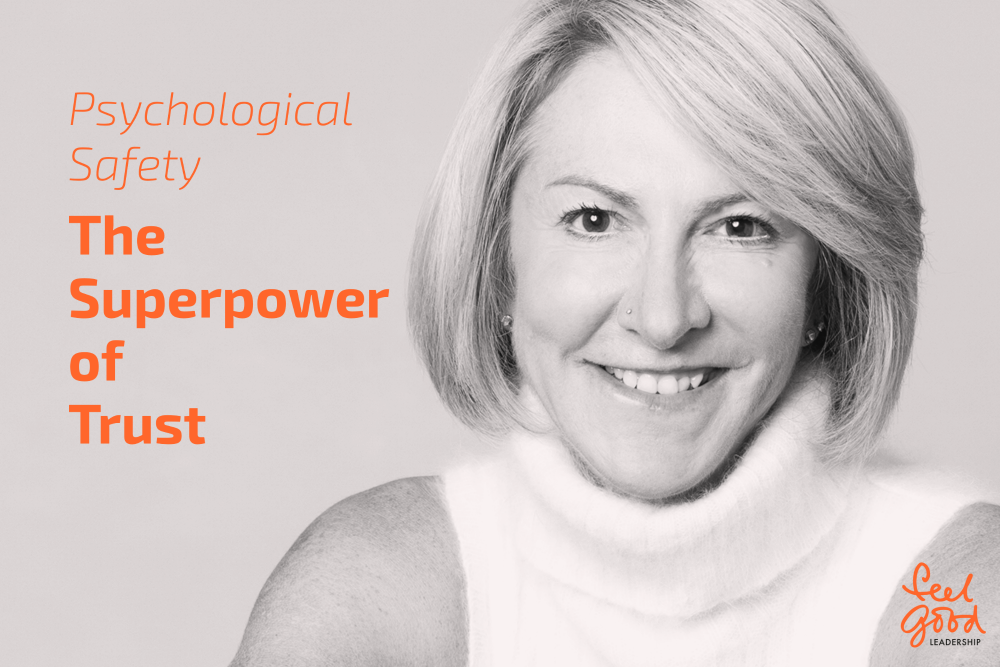
Psychological Safety: The Superpower of Trust
Psychological safety is at the heart of trust and when we have a climate of psychological safety we are more likely to share. We share ideas, problems, mistakes, and the truth. creative ideas and take risks when they trust it won’t jeopardize their performance or reputation. It’s one thing to tell our teams to “fail fast, fail often”, but how leaders actually react to mistakes is what matters.
In the 25 years I’ve been working with leaders, and teams, getting under the skin of how we behave and treat each other, I noticed a pattern – Psychological safety is the foundation of trust, engagement, and unlocking leadership superpower & potential
The biggest issue we all face is the lack of connection and feeling of separation.
Whether it’s a disconnected team, an international strategy, the problem remains the same. When we are not connected, we don’t feel safe, therefore, cannot thrive.
A culture that lacks engagement is a place where people don’t feel safe, seen, and heard. It is the culture from the behavior that generates un-rest. When we don’t feel understood, noticed, or valued for our contributions, we shrivel up and hide. It really is that simple – because we are all just human and we all need to be seen and heard.
 How does a lack of psychological safety manifest?
How does a lack of psychological safety manifest?
How many of the following do you feel are true for you?
- Overwhelmed with priorities
- A lack of clarity
- Blamed and judged
- Unable to voice opinions
- Not valued
- Exhausted
- Disempowered
If you answered yes to any of these – you are not alone. Human beings are inherently wired for connection and when leaders don’t provide the foundations for belonging and psychological safety in the workplace, our nervous systems cannot thrive.
If we don’t feel safe, we’re unable to make the authentic connections that make us feel human – we remain in a state of survival and easily get burnout. We loose our confidence in our ability and passion for our goals.
This is not becuase you are not capable, it’s becuase you feel under-valued and left out.
 Why is Psychological safety at the heart of building trust?
Why is Psychological safety at the heart of building trust?
The concept of psychological safety was first introduced by organizational behavioral scientist, Amy Edmondson, who coined the phrase and defined it as “a shared belief held by members of a team that the team is safe for interpersonal risk-taking”.
In 2015, Google embarked on a quest to build the perfect team. Their research – called Project Aristotle, a tribute to Aristotle’s quote, “the whole is greater than the sum of its parts”
Project Aristotle studied 180 teams at Google, conducted more than 200 interviews, and analyzed over 250 team attributes however things weren’t adding up. It wasn’t clear what successful teams shared in common. It wasn’t until Google started studying some intangibles that things became clearer.
Google looked at the team behaviors and characteristics that magnified the collective intelligence and ability of the group, identifying the following:
 5 key characteristics of high-performing teams from Google’s research
5 key characteristics of high-performing teams from Google’s research
- Psychological Safety– A sense that taking interpersonal risks with colleagues is rewarding, not threatening.
- Dependability – Team members that get things done on time and meet expectations.
- Structure & Clarity – Clear goals and well-defined roles within the group.
- Meaning – Their work has personal significance.
- Impact – Their work is purposeful and positively impacts the greater good.
![]()
 Why is psychological safety at the heart of innovation?
Why is psychological safety at the heart of innovation?
The nervous system’s response to connection and relaxation underpins psychological safety. Our social engagement system is the powerhouse of trust. This is the system involved in most aspects of social contact and pleasure. It is essential for calming our nervous system. Our social engagement system affects heart rate variability and the ability to read facial muscle cues. This enables us to the ability to be in resonance with ourselves and others.
Social engagement doesn’t mean “being sociable” – it means developing a wide window of tolerance to express and experience emotion. When we are socially engaged we are less likely to switch to a
 3 superpowers from psychological safety
3 superpowers from psychological safety
- Increases how much we learn from mistakes 1
- Boosts employee engagement 2,3
- Improves team innovation 4
Psychological Saftey – The leadership superpower that builds trust
![]()
 7 tips to build psychological safety & trust
7 tips to build psychological safety & trust
- Model curiosity and ask questions – have an inquiry mindset NOT a right or wrong frame
- Openly discuss mistakes – failure and mistakes are at the heart of innovation
- Have a clear team structure and clarity on roles and responsibilities – when we know what we are doing and understand our place, we feel safe. 5
- Be clear on how everyone can contribute to the purpose – when our contribution is valued, we feel safe and satisfied.
- Ensure everyone has an equal opportunity to be heard and voice their ideas.
- Takes turns to speak during discussions so everyone feels heard, accepted, and acknowledged.
- Form strong relationships between team members 6,7
![]()
These questions and criteria are just the beginning. In order to truly shift workplace culture and behavior so that people feel good, we need to embed psychological safety into the organization’s DNA. How do we do this?
 At Feel Good Leadership, we coach executive leaders, managers, and teams to institutionalize empathy and connection – form and nurture better relationships with team members – and allow ‘whole-brain’ thinking to create thriving workplaces. Please contact Jenny for a discovery call on how your leaders can develop a culture of trust and take a look at our 1:1 coaching program the Leadership burst to unlock leadership superpower and look at how you could train your staff to facilitate a psychologically safe space.
At Feel Good Leadership, we coach executive leaders, managers, and teams to institutionalize empathy and connection – form and nurture better relationships with team members – and allow ‘whole-brain’ thinking to create thriving workplaces. Please contact Jenny for a discovery call on how your leaders can develop a culture of trust and take a look at our 1:1 coaching program the Leadership burst to unlock leadership superpower and look at how you could train your staff to facilitate a psychologically safe space.
References:
1. Edmondson, A. C. (1 March 1996). “Learning from Mistakes is Easier Said Than Done: Group and Organizational Influences on the Detection and Correction of Human Error”. The Journal of Applied Behavioral Science. 32 (1): 5–28. doi:10.1177/0021886396321001.
2. ^ Kark, Ronit; Carmeli, Abraham (1 August 2009). “Alive and creating: the mediating role of vitality and aliveness in the relationship between psychological safety and creative work involvement”. Journal of Organizational Behavior. 30 (6): 785–804. doi:10.1002/job.571.
3. ^ Jump up to:a b Nembhard, Ingrid M.; Edmondson, Amy C. (1 November 2006). “Making it safe: the effects of leader inclusiveness and professional status on psychological safety and improvement efforts in health care teams”. Journal of Organizational Behavior. 27 (7): 941–966. doi:10.1002/job.413.
4. ^ West, Michael A.; Anderson, Neil R. (1 January 1996). “Innovation in top management teams”. Journal of Applied Psychology. 81 (6): 680–693. doi:10.1037/0021-9010.81.6.680.
5. Bunderson, J. S.; Boumgarden, P. (4 December 2009). “Structure and Learning in Self-Managed Teams: Why “Bureaucratic” Teams Can Be Better Learners”. Organization Science. 21 (3): 609–.
6. ^ Carmeli, Abraham; Gittell, Jody Hoffer (1 August 2009). “High-quality relationships, psychological safety, and learning from failures in work organizations”. Journal of Organizational Behavior. 30 (6): 709–729. doi:10.1002/job.565.
7. ^ Schulte, M.; Cohen, N. A.; Klein, K. J. (22 October 2010). “The Coevolution of Network Ties and Perceptions of Team Psychological Safety”. Organization Science. 23 (2): 564–581. doi:10.1287/orsc.1100.0582.







